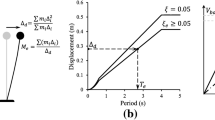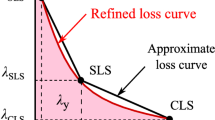Abstract
Performance-based earthquake engineering (PBEE) has traditionally implied the verification of limit states at different earthquake intensities, where recent developments advocate a more risk-consistent approach. This has been primarily investigated for assessing existing structures and typically involves extensive analyses using detailed numerical models and ground motions. For new design, structures must be sized and detailed before more advanced numerical verifications are performed and the final design solution is established. In assessment, simplified procedures have been developed to incorporate further aspects of PBEE and typically comprise extensions to traditional structural analysis methods. Displacement-based assessment is one such method and while it has been extended for PBEE in the past, its use in a risk-oriented context still requires some validation. This article presents such a study, where recent developments in simplified analysis to estimate the exceedance rates of both storey drift and floor acceleration in reinforced concrete frames are described. This gives a method that is simple in its application, since it doesn’t require extensive and detailed numerical modelling or analysis, but also sufficiently accurate in its quantification of performance. While not intended as a substitute to extensive verification analysis, such a method for quantifying structural demand exceedance rates can be used to check results and provide better understanding to risk analysts. The work described herein can also be used in simplified verification analysis of new designs, whereby trial solutions may be verified in a relatively easy manner before more extensive verifications are carried out via non-linear dynamic analysis. It represents a further extension to existing simplified methods that strive toward more advanced performance quantification in line with the needs and goals of PBEE.











Similar content being viewed by others
References
Ancheta TD, Darragh RB, Stewart JP, Seyhan E, Silva WJ, Chiou BSJ, Wooddell KE et al (2013) PEER NGA-West2 database. PEER report 2013/03. http://ngawest2.berkeley.edu/
ASCE (2017) ASCE/SEI 7-16 minimum design loads for buildings and other structures. ASCE Standard. American Society of Civil Engineers, Reston. https://doi.org/10.1061/9780784412916
Bradley BA, Dhakal RP (2008) Error estimation of closed-form solution for annual rate of structural collapse. Earthq Eng Struct Dyn 37(15):1721–1737. https://doi.org/10.1002/eqe.833
Calvi PM, Sullivan TJ (2014) Estimating floor spectra in multiple degree of freedom systems. Earthq Struct 7(1):17–38. https://doi.org/10.12989/eas.2014.7.1.017
Cornell C Allin, Krawinkler H (2000) Progress and challenges in seismic performance assessment. PEER Center News 3(2):1–2
Cornell C Allin, Jalayer F, Hamburger RO, Foutch DA (2002) Probabilistic basis for 2000 sac federal emergency management agency steel moment frame guidelines. J Struct Eng 128(4):526–533. https://doi.org/10.1061/(ASCE)0733-9445(2002)128:4(526)
Fajfar P, Dolšek M (2012) A practice-oriented estimation of the failure probability of building structures. Earthq Eng Struct Dyn 41(3):531–547. https://doi.org/10.1002/eqe.1143
FEMA (2012) FEMA P-58-1: seismic performance assessment of buildings: volume 1—methodology. Washington
Gokkaya BU, Baker JW, Deierlein GG (2016) Quantifying the impacts of modeling uncertainties on the seismic drift demands and collapse risk of buildings with implications on seismic design checks. Earthq Eng Struct Dyn 45(10):1661–1683. https://doi.org/10.1002/eqe.2740
Haselton CB, Goulet CA, Mitrani Reiser J, Beck JL, Deierlein GG, Porter KA, Stewart JP, Taciroglu E (2007) An assessment to benchmark the seismic performance of a code-conforming reinforced concrete moment-frame building. PEER report 2007/12
Haselton CB, Liel AB, Taylor Lange S, Deierlein GG (2008) Beam-column element model calibrated for predicting flexural response leading to global collapse of RC frame buildings. PEER report 2007/03
McKenna F, Scott MH, Fenves GL (2010) Nonlinear finite-element analysis software architecture using object composition. J Comput Civ Eng 24(1):95–107. https://doi.org/10.1061/(ASCE)CP.1943-5487.0000002
Miranda E, Akkar SD (2006) Generalized interstory drift spectrum. J Struct Eng 132(6):840–852. https://doi.org/10.1061/(ASCE)0733-9445(2006)132:6(840)
Monelli D, PaganiM, Weatherill G, Silva V, Crowley H (2012) The hazard component of OpenQuake: the calculation engine of the global earthquake model. In: 15th world conference on earthquake engineering. Lisbon, Portugal
Nafeh AMB, O’Reilly GJ, Monteiro R (2019) Simplified seismic assessment of infilled RC frame structures. Bull Earthq Eng. https://doi.org/10.1007/s10518-019-00758-2
O’Reilly GJ, Calvi GM (2019) Conceptual seismic design in performance-based earthquake engineering. Earthq Eng Struct Dyn 48(4):389–411. https://doi.org/10.1002/eqe.3141
O’Reilly GJ, Monteiro R (2019) Probabilistic models for structures with bilinear demand–intensity relationships. Earthq Eng Struct Dyn 48(2):253–268. https://doi.org/10.1002/eqe.3135
Priestley MJN (1997) Displacement-based seismic assessment of reinforced concrete buildings. J Earthq Eng 1(1):157–192. https://doi.org/10.1080/13632469708962365
Priestley MJN, Calvi GM, Kowalsky MJ (2007) Displacement Based Seismic Design of Structures. IUSS Press, Pavia
SEAOC (1995) Vision 2000: performance-based seismic engineering of buildings. Sacramento, California
Suzuki A, Iervolino I (2019) Hazard-consistent intensity measure conversion of fragility curves. In: 13th International Conference on Applications of Statistics and Probability in Civil Engineering(ICASP13), Seoul, South Korea, May 26–30, 2019. https://doi.org/10.22725/ICASP13.276
Vamvatsikos D (2013) Derivation of new SAC/FEMA performance evaluation solutions with second-order hazard approximation. Earthq Eng Struct Dyn 42(8):1171–1188. https://doi.org/10.1002/eqe.2265
Vamvatsikos D (2017) Performance-based seismic design in real life: the good, the bad and the ugly. In: ANIDIS 2017. Pistoia, Italy
Vamvatsikos D, Allin Cornell C (2002) Incremental dynamic analysis. Earthq Eng Struct Dyn 31(3):491–514. https://doi.org/10.1002/eqe.141
Welch DP (2016) Non-structural element considerations for contemporary performance-based earthquake engineering. PhD Thesis, IUSS Pavia, Pavia, Italy
Welch DP, Sullivan TJ, Calvi GM (2014) Developing direct displacement-based procedures for simplified loss assessment in performance-based earthquake engineering. J Earthq Eng 18(2):290–322. https://doi.org/10.1080/13632469.2013.851046
Woessner J, Laurentiu D, Giardini D, Crowley H, Cotton F, Grünthal G, Valensise G et al (2015) The 2013 European seismic hazard model: key components and results. Bull Earthq Eng 13(12):3553–3596. https://doi.org/10.1007/s10518-015-9795-1
Acknowledgements
The work presented in this paper has been developed within the framework of the project “Dipartimenti di Eccellenza”, funded by the Italian Ministry of Education, University and Research at IUSS Pavia.
Author information
Authors and Affiliations
Corresponding author
Additional information
Publisher's Note
Springer Nature remains neutral with regard to jurisdictional claims in published maps and institutional affiliations.
Appendix: Intensity measure conversion
Appendix: Intensity measure conversion
For a smoothed code spectrum of uniform hazard, the shape is generally fixed and the corresponding value of Sd(T1) can be simply read by scaling it to match the identified point for the equivalent system and reading the value at T1, as shown in Fig. 12a. When using PSHA data, where seismic hazard data is typically provided for a specified number of vibration periods, the conversion becomes slightly more complicated. Consider Fig. 12b, where the site hazard curves for two different vibration periods are known. What is essentially happening is that knowing Sa(Te) for a given return period or mean annual frequency of exceedance (MAFE), Sa(T1) can be computed via the relation between the hazard curves at the two vibration periods. Since PSHA data is typically provided as raw data in the form of a site hazard curve, H(Sa), it would be desirable if a closed-form means of IM conversion could be established. Here, a relatively simple means of converting from one intensity measure to another was sought. It relies simplifying the site hazard curve, but it is noted that other more detailed and thorough ways of converting from one intnesity measure to another are available (e.g. Suzuki and Iervolino 2019).
For the site hazard curves shown in Fig. 12b, some past researchers have attempted to provide means with which to fit expressions. Cornell et al. (2002) described how the H(Sa) relationship could be approximated by a straight line in logspace. This linear representation was later expanded to become a second-order polynomial, which also better represents the hazard curve over a wider IM range and is described by:
where k0, k1 and k2 are best-fit parameters to be established for each individual hazard curve. As shown in Fig. 12b, these will be two separate hazard curves at Te and T1 and are denoted He and H1, respectively. What is of interest here is the value of Sa(T1) when Sa(Te) is known when He and H1 are equal. Assuming that the best-fit parameters for both hazard curves are known, it follows that:
Setting He equal to H1 gives:
Rearranging to give:
and taking the natural logarithm of both sides then gives:
Letting ln Sa(T1) equal X and rearranging gives:
which results in a quadratic polynomial that can be solved as:
Substituting back in for X gives:
which will return two solutions, one of which will be unrealistic. This expression provides a means with which a common intensity measure can be found for any effective period of vibration, Te, to give a consistent demand–intensity relationship in Sa(T1).
Rights and permissions
About this article
Cite this article
O’Reilly, G.J., Calvi, G.M. Quantifying seismic risk in structures via simplified demand–intensity models. Bull Earthquake Eng 18, 2003–2022 (2020). https://doi.org/10.1007/s10518-019-00776-0
Received:
Accepted:
Published:
Issue Date:
DOI: https://doi.org/10.1007/s10518-019-00776-0





